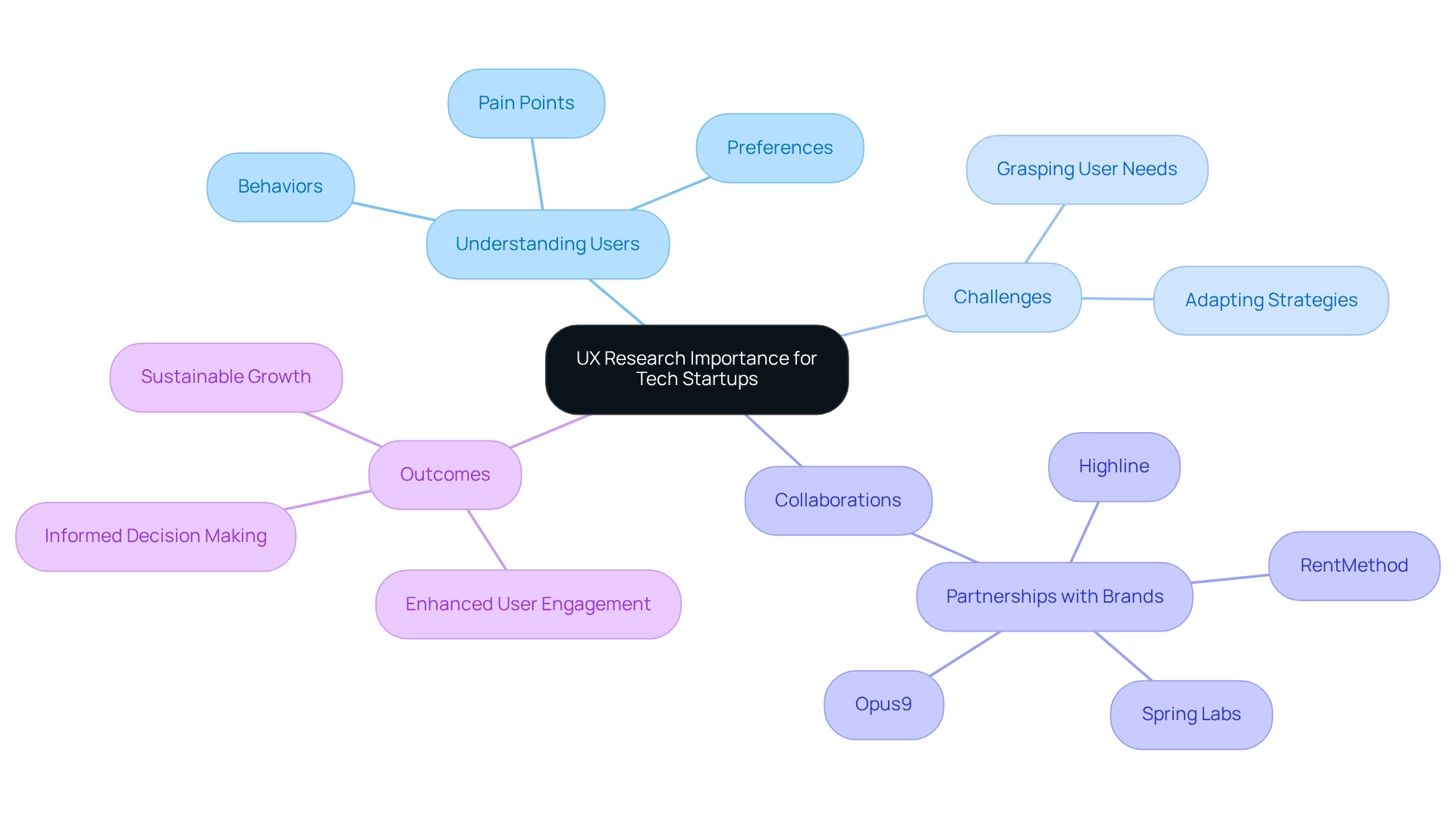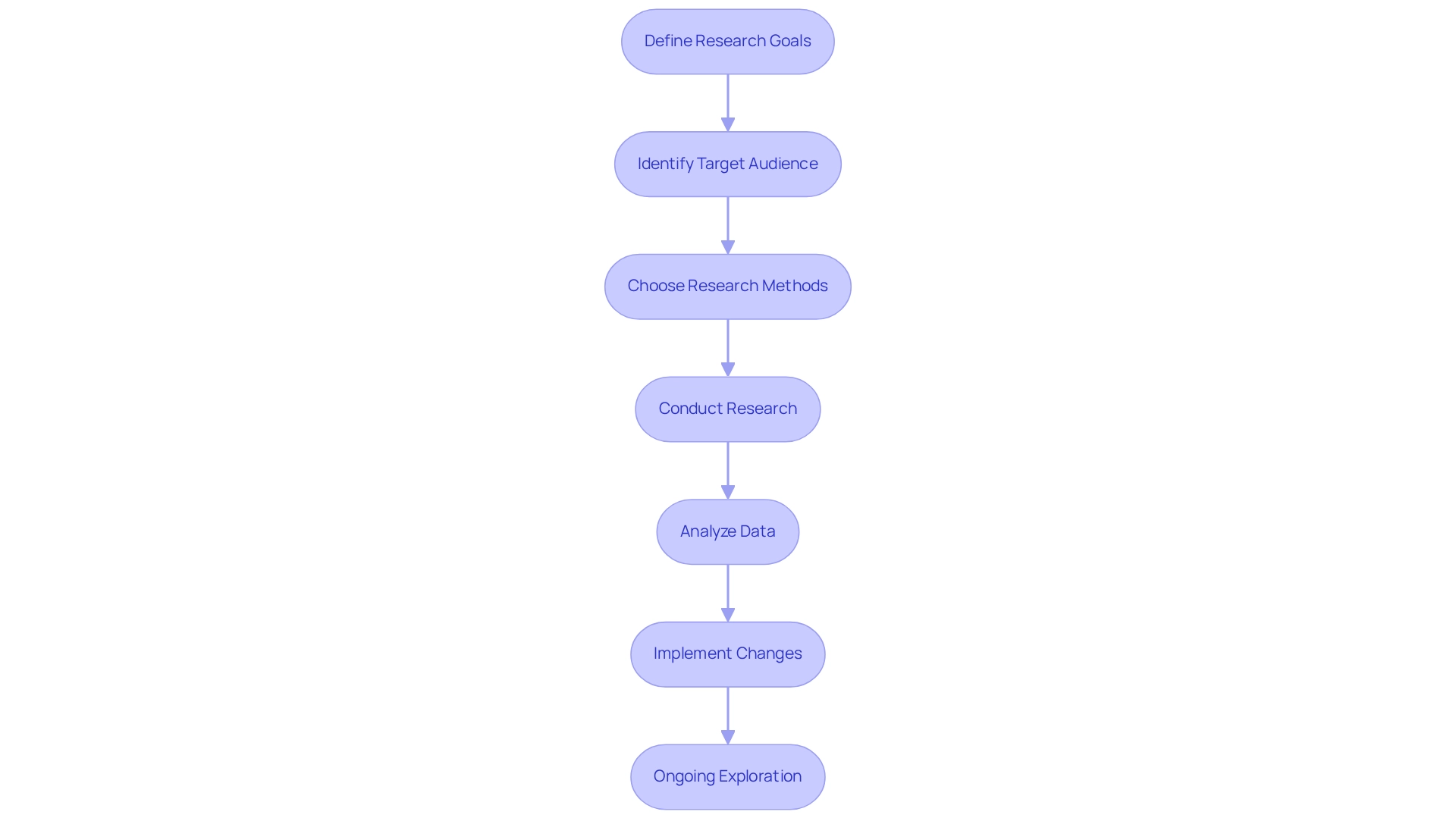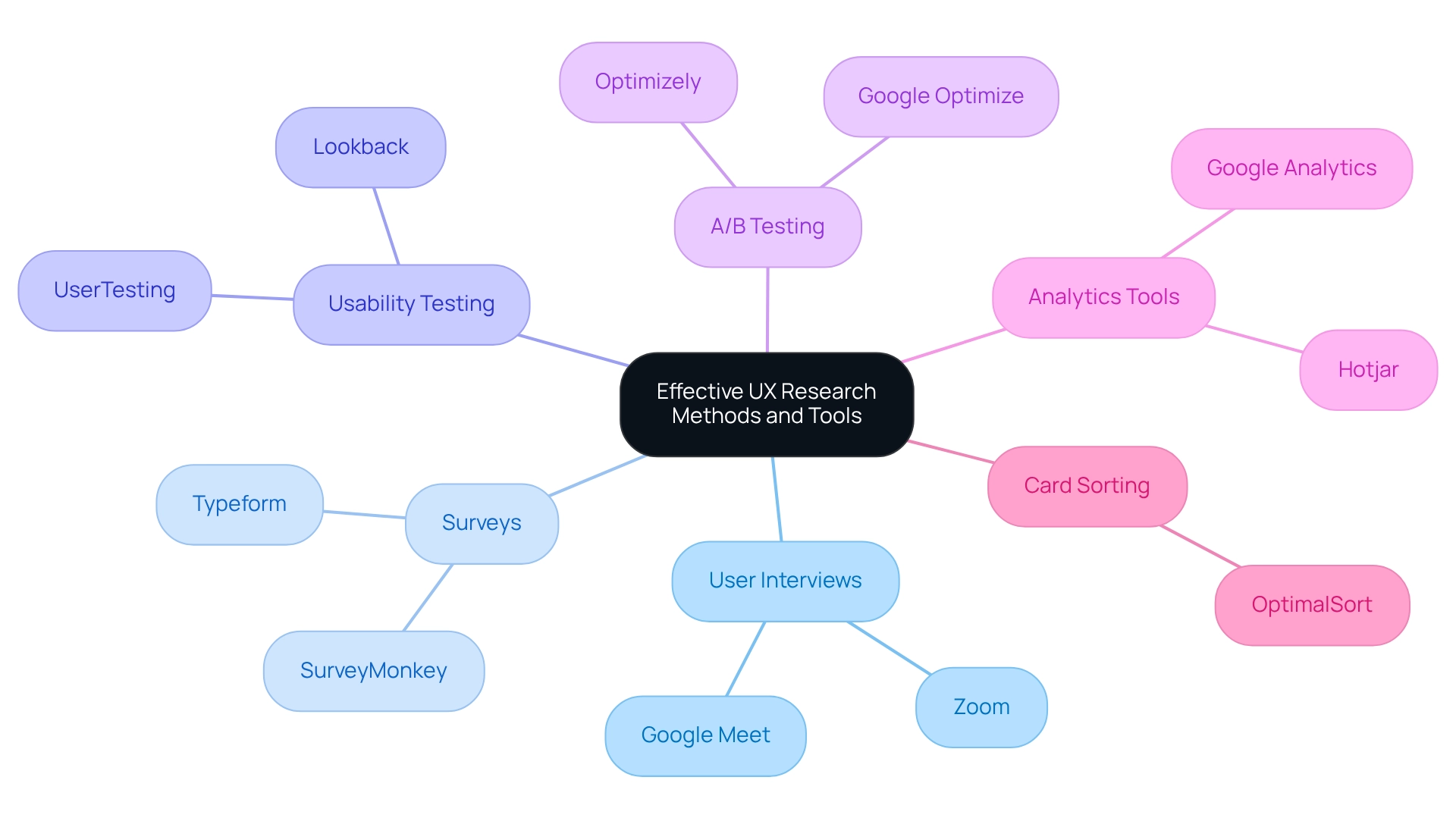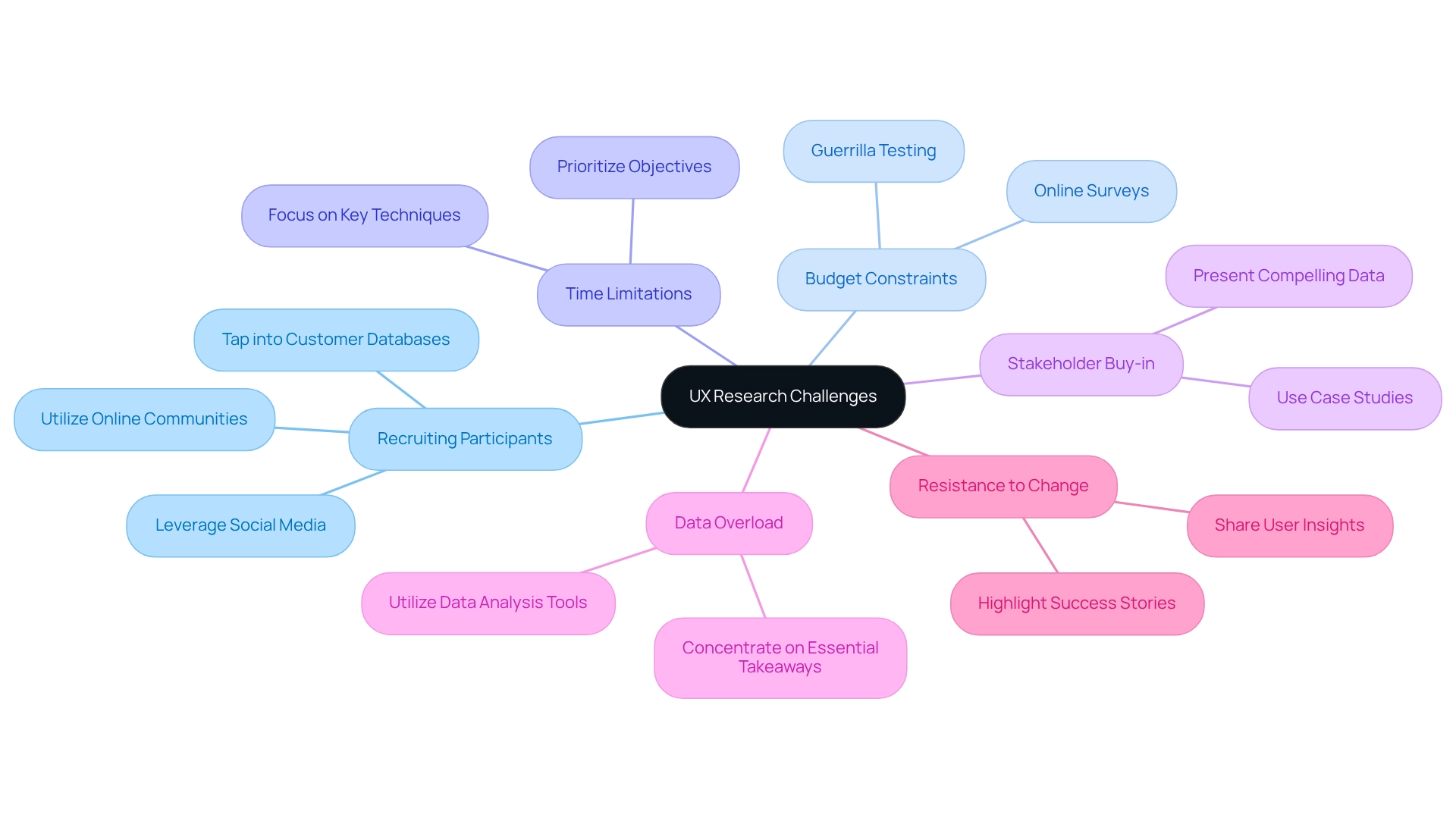Overview
The article addresses a common challenge faced by tech startups: the struggle to truly understand user needs. This gap can lead to missed opportunities and hindered product development, leaving founders feeling overwhelmed and uncertain. By emphasizing the importance of mastering the UX research process, the article highlights how this critical step can illuminate the path forward, fostering informed decision-making that supports sustainable growth.
Through a compassionate lens, it outlines a step-by-step approach to UX research, addressing the typical hurdles that founders encounter along the way. These challenges can feel daunting, but with the right guidance, they can be transformed into stepping stones toward success. Effective UX research not only clarifies user expectations but also empowers startups to create products that resonate deeply with their audience.
Ultimately, the article serves as a nurturing resource for founders, illustrating that with dedication and the right tools, they can navigate the competitive landscape with confidence. By embracing the insights shared, startup leaders can cultivate a stronger connection with their users, paving the way for innovation and growth.
Introduction
In the ever-changing landscape of technology, many startup founders find themselves grappling with the challenge of meeting evolving user expectations. This can be a daunting task, as understanding the intricacies of User Experience (UX) research is essential for carving out a successful niche. By taking the time to delve into the minds of their target audience, tech startups can uncover invaluable insights that not only inform product development but also significantly enhance user satisfaction.
This article aims to explore the fundamental aspects of UX research, shedding light on its significance, the step-by-step process, effective methods and tools, and the common challenges faced during research.
With a strategic and nurturing approach to UX research, startups can not only avoid costly missteps but also position themselves for sustainable growth in a competitive landscape.
We invite you to join us on this journey, as we navigate the path to understanding your users better and building products that resonate deeply with them.
Define UX Research and Its Importance for Tech Startups
The ux research process represents a crucial step for tech startups, as it entails the careful examination of intended audiences and their needs. This process is not just about data; it’s about understanding the real-life contexts and insights that inform design.
For many startups, the challenge lies in grasping the behaviors, preferences, and pain points of their users. This understanding is vital, as it allows them to create offerings that not only attract individuals but also foster lasting relationships, ultimately paving the way for sustainable growth.
At RNO1, we embody this commitment to design-driven solutions, collaborating with brands like RentMethod and Spring Labs to elevate their digital experiences and drive scalable growth. By prioritizing the ux research process, startups can sidestep costly missteps and adapt their strategies based on authentic feedback, ensuring their offerings resonate with market needs.
In today’s competitive landscape, where client expectations shift rapidly, the ux research process serves as a guiding light for startups in their product development journey. It empowers them to make informed decisions, significantly enhancing their chances of success in the market.
Our transformative collaborations, including partnerships with tech startups and established brands like Opus9 and Highline, illustrate how effective UX analysis can lead to innovative solutions that redefine user engagement and satisfaction. We understand the pressures you face, and we’re here to support you in navigating these challenges with compassion and expertise.

Outline the Step-by-Step UX Research Process
The UX research process can feel daunting, particularly when you're striving to create meaningful experiences for your users. Understanding the needs of individuals, testing prototypes, or measuring satisfaction can seem overwhelming. However, breaking the UX research process down into key steps can help alleviate some of that pressure.
-
Define your research goals. What do you truly want to learn? This clarity can guide your efforts and ensure you’re focused on what matters most to your audience.
-
Identify your target audience. Who are they? Developing audience personas can help you visualize and understand the different segments of your users, making your research more effective and relatable.
-
Choose the right research methods. Select approaches that align with your goals, whether it’s through surveys, interviews, usability testing, or field studies. Each method has its strengths, and the right choice can illuminate the insights you seek.
-
Conduct your research. Gather both qualitative and quantitative data to paint a comprehensive picture of user experiences. This is where the magic happens, as you start to uncover the stories behind the numbers.
-
Analyze your data. Look for patterns, findings, and areas for improvement. This step is crucial in the UX research process, as it transforms raw data into actionable insights and synthesizes your findings by summarizing the results to highlight key observations and actionable suggestions. This not only clarifies your insights but also empowers your team to make informed decisions.
-
Implement the changes based on your insights. Use the knowledge you’ve gained to guide your design and development processes, ensuring that the needs of your users remain at the forefront of your solutions.
-
Remember that UX exploration is an ongoing journey. Continuously collect feedback and refine your offerings based on user interactions and evolving requirements. By embracing this iterative process in the UX research process, you create a culture of improvement that resonates with your audience, addressing the challenges of UX research and fostering a nurturing environment where users feel valued and understood.

Identify Effective UX Research Methods and Tools
Navigating the UX research process can be a daunting task for tech startups. Many founders grapple with understanding their users' needs and experiences, which can lead to frustration and uncertainty in product development. This challenge not only impacts your team's morale but also affects the satisfaction of your users. However, there are several effective tools and methods in the UX research process that can help you gather valuable insights and foster a deeper connection with your audience.
-
User Interviews are a wonderful way to gain in-depth insights about user experiences and expectations. Conducting one-on-one interviews allows you to hear directly from your users, helping you understand their needs on a personal level. Tools like Zoom or Google Meet can facilitate remote interviews, making it easier to connect with users regardless of location.
-
Surveys are another powerful tool. Utilizing online survey platforms such as SurveyMonkey or Typeform enables you to collect quantitative data from a larger audience. This can provide a broader understanding of user preferences and behaviors, which is essential for informed decision-making.
-
Usability Testing is crucial as well. By evaluating your offering with actual participants, you can see how they engage with your product. Tools like UserTesting or Lookback can help facilitate this process, ensuring you gather meaningful feedback that can guide your improvements.
-
A/B Testing allows you to experiment with different versions of your offering to determine which performs better. Tools like Optimizely or Google Optimize are invaluable for this, helping you make data-driven decisions that enhance user satisfaction.
-
Analytics Tools such as Google Analytics or Hotjar are essential for tracking behavior on your website or app. These insights reveal how individuals interact with your product, shedding light on areas for improvement.
-
Card Sorting is a technique that helps you understand how users categorize information. Tools like OptimalSort can assist in conducting these exercises, providing clarity on user thought processes.
Finally, creating Personas and Journey Mapping can visualize experiences and identify pain points. Tools like Miro or Lucidchart can be incredibly helpful in the UX research process, as they allow you to empathize with your users' journeys. By employing these methods and tools within the UX research process, you can gather invaluable insights that inform your product development and enhance user satisfaction. Remember, you are not alone in this journey; by understanding and addressing your users' needs, you can create a product that truly resonates with them.

Troubleshoot Common UX Research Challenges
Tech startups often face significant challenges during the UX research process, and it’s crucial to acknowledge these hurdles. For instance, recruiting the right participants can feel daunting. This struggle can lead to feelings of isolation, but you can overcome it by leveraging social media, online communities, and your existing customer databases to connect with potential users.
Moreover, budget constraints can restrict your investigative capabilities, leaving you feeling limited. However, consider low-cost approaches such as guerrilla testing or online surveys. These methods allow you to gather valuable insights without straining your finances.
Time limitations are another common pain point; startups frequently operate under tight deadlines. This can create pressure, but by prioritizing your objectives and focusing on key techniques, you can gain significant understanding in a shorter timeframe.
Gaining stakeholder buy-in can also be a challenge, often leading to frustration. To navigate this, present compelling data and case studies that highlight the value of UX analysis in driving product success. This approach can help secure their commitment and support.
Additionally, the overwhelming nature of data overload can leave you feeling lost. Utilize data analysis tools to help synthesize your findings, concentrating on essential takeaways that align with your objectives.
Lastly, resistance to change within teams can hinder progress, causing feelings of stagnation. To foster a culture of user-centered design, regularly share user insights and success stories. This practice encourages the adoption of research-driven decisions and nurtures a supportive environment.
By anticipating these challenges and employing effective strategies to address them, tech startups can enhance their UX research process and ultimately improve their product offerings. Remember, you’re not alone in this journey; embracing these solutions can lead to meaningful progress.

Conclusion
Investing in User Experience (UX) research is not just important; it’s vital for tech startups striving to succeed in a competitive landscape. Many founders find themselves grappling with the challenge of understanding user behaviors and preferences. This struggle can lead to products that fail to attract or retain users, hindering sustainable growth. By embracing a systematic approach to UX research—from defining research goals to implementing necessary changes—startups can ensure that user needs take center stage in product development.
Utilizing effective UX research methods and tools, such as user interviews, surveys, and usability testing, enables startups to gather valuable insights. These insights are crucial for guiding design decisions and enhancing user satisfaction. Yet, it’s common for challenges like participant recruitment, budget limitations, and securing stakeholder support to arise, potentially obstructing the research process. By proactively addressing these hurdles, startups can streamline their UX research efforts, leading to data-driven decisions that truly resonate with their target audience.
In closing, a thoughtful approach to UX research not only helps avoid costly mistakes but also empowers tech startups to innovate and adapt to the evolving expectations of users. By prioritizing the user experience, startups can foster a loyal customer base and solidify their market presence, ultimately paving the way for long-term success. Embracing UX research as a fundamental aspect of the product development journey is not merely advantageous; it is essential for crafting products that genuinely connect with users. Together, let’s navigate this journey and create experiences that matter.
Frequently Asked Questions
Why is the UX research process important for tech startups?
The UX research process is crucial for tech startups as it involves examining intended audiences and their needs, which helps in understanding user behaviors, preferences, and pain points. This understanding is essential for creating offerings that attract users and foster lasting relationships, leading to sustainable growth.
What challenges do startups face regarding UX research?
Startups often struggle to grasp the behaviors, preferences, and pain points of their users, which can hinder their ability to create effective products and services that resonate with the market.
How can prioritizing UX research benefit startups?
By prioritizing UX research, startups can avoid costly missteps, adapt their strategies based on authentic feedback, and ensure their offerings align with market needs, significantly enhancing their chances of success.
What role does UX research play in product development?
UX research serves as a guiding light in the product development journey for startups, empowering them to make informed decisions and adapt to rapidly shifting client expectations in a competitive landscape.
Can you provide examples of successful collaborations that emphasize the importance of UX research?
RNO1 has collaborated with brands like RentMethod, Spring Labs, Opus9, and Highline, demonstrating how effective UX analysis can lead to innovative solutions that enhance user engagement and satisfaction.
How does RNO1 support startups in their UX research efforts?
RNO1 supports startups by embodying a commitment to design-driven solutions and providing expertise to help navigate the challenges of UX research, ensuring that their digital experiences drive scalable growth.




